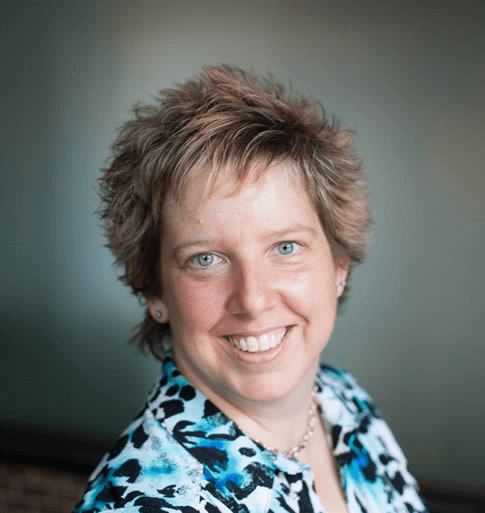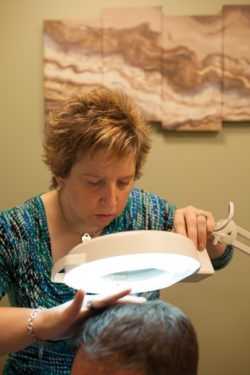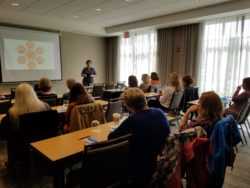Skinny On Skin Spotlight: Hair and Scalp 360’s Sharon Clohesy

![]()
The Skinny On Skin is a program IMPACT Melanoma launched to aide stylists, estheticians, nail technicians, bodyworkers, and other health and skin professionals as a training aimed to educate these frontline professionals to recognize suspicious lesions on their clients’ skin and encourage their clients to seek medical care as needed from a dermatologist or other health professional for an official diagnosis in a further effort to combat skin cancer diagnoses nationwide. Using an eLearning lesson, the training is digital and can be found here on our website. That said, we encourage this sort of thing to anyone with an interest and, lucky for us, there are interested, kind and passionate people who do just that.
Today we’d like to highlight one such partner in prevention, Sharon Clohesy of Hair and Scalp 360. Read on to learn how Sharon got involved with IMPACT and what her thoughts are on the benefits of the Skinny On Skin program.
Tell us about your profession. What does the day-to-day entail? What do you enjoy about your work?
I’m a certified trichologist, a licensed cosmetologist, and a licensed educator. I see clients working behind the chair as a hair stylist, cutting and coloring. As a certified I.A.T. trichologist I see clients with a variety of hair and scalp conditions. I help each client understand the cause of their condition, including how they can address their concerns.
I love the fact that I get to work with my clients one on one and that I get to help each client beyond their haircut and color services.
How’d you learn about IMPACT Melanoma? Tell us about the initial engagement with the team.
Before I found IMPACT Melanoma and this program I actually had two clients that I found something suspicious on their scalp, I sent them to their doctors and they both wound up being a type of skin cancer. Shortly after, probably within a month, I received a postcard in the mail all about IMPACT Melanoma’s Skinny On Skin program. I was ecstatic. The doctors that my clients had followed up with sent the message back with them of kudos to your hairstylist for discovering and mentioning the suspicious area, and I just kept thinking, ‘oh my gosh, how many other clients out there – stylists wouldn’t know what to look for… I mean, for me, I didn’t know what I was looking for at that time either, so the existence of a program like this felt imperative to me. We as stylists can’t diagnose, and aren’t asked to with the Skinny On Skin course, because we’re not doctors, but having a base of knowledge is infinitely beneficial. I see my clients every four to six weeks, so I know if something looks different and what doesn’t… This program is exactly what we need.
I never really thought about the idea of finding suspicious spots on clients’ skin until it happened. I knew enough to say, ‘hey wait a minute, this isn’t the same as it was four to six weeks ago.’ I always air on the side of caution, as you should being a professional. Our clients come to us because they trust us, so we need to not only make sure we’re conducting the correct and proper practices as a cosmetologist, but we also need to take caution overall. When I noticed something wasn’t the same, I knew enough to not apply the color to my client’s hair and suggest they go see their doctor. I knew something was wrong but I didn’t know what it was. That initiative to identify and recognize things like this is the next step in being able to ensure that hair stylists, barbers and trichologists have the knowledge to point their client towards medical opinion if you see something that warrants that type of referral.
I like working with IMPACT Melanoma because the course has a lot of great and beneficial information that hair stylists and other professionals looking at their clients’ skin need to know. We’re already doing half of the job – we’re already working on our clients’ hair and scalp; more so than any other profession out there, so we’re essentially the frontline of another level of professionalism, which is to keep each client healthy.
 You’ve been actively working with IMPACT’s Skinny On Skin eLearning course and positioning it as an operative piece of your work. Why is this work important and adding the lessons learned with SOS as a “value add” for your clients?
You’ve been actively working with IMPACT’s Skinny On Skin eLearning course and positioning it as an operative piece of your work. Why is this work important and adding the lessons learned with SOS as a “value add” for your clients?
I absolutely believe that each of my clients will benefit from me attending this program. As a professional, offering a variety of services to our clients every day we have the ability to make a difference. This program gives us the ability to make a difference at a whole new level. As a trichologist myself I always bring up being able to recognize suspicious lesions on the scalp and skin as a working piece of my trainings. I feel that the way the Skinny On Skin program is structured is very beneficial and offers a very high quality level of education. I strongly believe the program would be a great added benefit to all cosmetology and barber trainings and certification curriculums. It could also be very beneficial to incorporate as a continuing education program for cosmetologists and barbers.
What do you appreciate about the Skinny On Skin program?
I do a lot of education on top of my general stylist work. I do a lot of education for other licensed hair stylists. I’m always recommending and referring the program because I know how much it helped me and how much it helped my clients. I know every hair stylist out there sees many clients in a day, week, or month, that they could help beyond a haircut and color. So I’m always advocating for the Skinny On Skin program because I think it’s really important to practice this next level of help or, rather, service.
What have you learned from your collective experience? How have your students responded? What has the feedback been like?
I bring up the Skinny On Skin program in all of my classes, and, honestly, all of the students wind up excited about it as well. I know that some of them pull it right up on their phone when we’re in class or on break. One of the big things is I think a lot of hair stylists get nervous or set back about whether or not they think they’re able to extend that knowledge or if and how they should approach their client with the knowledge, and part of the program teaches exactly that. I try to help stylists understand that they can do this and that it’s just as easy as talking to a client about a hair color or a new style or even a haircut – it’s a valuable way to talk to them about their health. We’re there to offer a level of care that again, goes beyond just the service of shaping their hair style. The course does not ask stylists to act as a doctor or diagnose anyone, but to recognize something that may be suspicious, how to best talk to their clients about what they see and encourage them to have it looked at by a medical professional.
What is your own personal philosophy in regard to sun safety? Tell us your “survival story.” Why does this sort of programming/initiative hit home?
I think it’s very important. I always try to talk to clients about protecting their skin, whether it’s moisturizing or applying sun protection. And again, we see a lot of clients with different hair textures and densities and we are the frontline other than dermatologists of helping clients practice sun safety, for their hair color, and their scalp protection to their overall skin protection, which is obviously all very important subjects. Being able to talk about the damage the sun does and offer advice once again raises that level of professionalism that we are able to offer our clients.
 What sort of impact does this program leave on your direct community, and, in turn, an extended network/community?
What sort of impact does this program leave on your direct community, and, in turn, an extended network/community?
I truly believe that the program really should be used by all in the industry. I feel more hair stylists, barbers and estheticians should take advantage of the course because they’d benefit tremendously from the experience. My fear is that a lot of my peers may not know about the program, so I’ve been really trying to make a difference with advocating for the Skinny On Skin program and making them aware that it exists. I think when a hair stylist understands that even a small amount of this information that they can take away from IMPACT Melanoma’s Skinny On Skin program can be so powerful and the choice to grow professionally helps their clients in another way and quite literally position themselves to save a life. That’s big.
What’s your battle cry sound like with regard to getting surrounding communities, cosmetology schools, salons, etc., in your area, and across the globe to adopt a similar proactive approach to helping combat skin cancer?
I can’t stress enough about how important I feel this program is. Finding it kind of happened in reverse for me, but knowing now what I see and what I can be aware of is empowering. But again, we’re not medical professionals so we’d never diagnose anyone, but just having the information to recognize something that ought to be examined further by a medical professional can really help our clients tremendously.
Feel free to add anything we may not have addressed that you would like to get across.
I can’t stress enough about the importance of this program, our clients are like our family, every salon should implement it as a piece of their internal education initiative, it will benefit us all!
###
It’s strong advocates like Sharon that are helping us to collectively make a great IMPACT in communities around the United States and beyond. Consider getting involved. If you’d like to take the course or become a Skinny On Skin Ambassador visit impactmelanoma.org.

